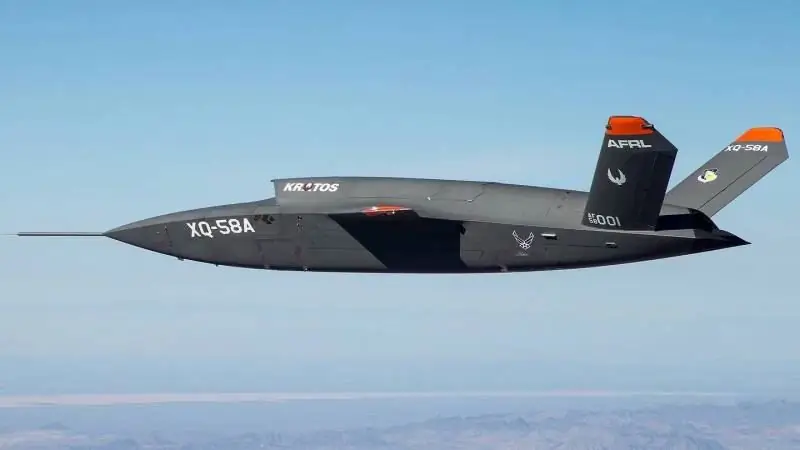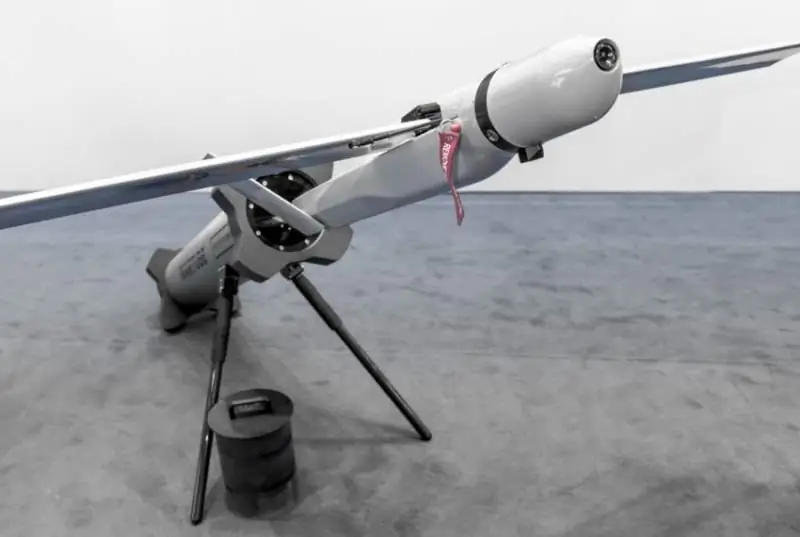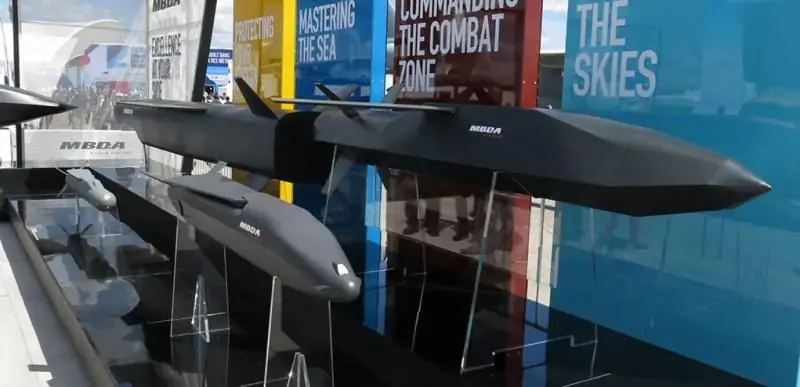- Author Matthew Elmers [email protected].
- Public 2023-12-16 21:49.
- Last modified 2025-01-24 09:17.

Currently, there is a steady development of the concept of conducting swarm operations from the air, land and sea with the use of many "deserted" systems, since in order to defeat opponents, the armed forces of many countries pay great attention to the deployment of advanced autonomous technologies. However, the development of such technologies at the moment is mainly focused on air swarms and it is unlikely that in the near future they will be able to have a significant impact on the outcome of military operations.
Nonetheless, the deployment of swarms of air, ground, surface and submarine autonomous platforms is forcing the military to tackle the daunting challenges of maintaining and funding this technology, despite its relatively recent introduction.
For example, according to Secretary of Defense Gavin Williamson, who spoke at the Royal Defense Research Institute a year ago, the UK Department of Defense Transformation Fund “was tasked with developing swarm squadrons of networked drones capable of confusing and stunning enemy air defenses. We hope the technology will be ready for deployment by the end of this year.”
High-ranking officials from the US Special Operations Command agree in principle with this position. "The totality of unmanned systems working on a common mission remains an integral part of the Command's roadmap for its promising concept" Special applications for special situations ", - said the head of programs for aircraft type devices.
His commentary is consistent with those of the Command, which talked about how swarm technology could support the "tactical information awareness" of special forces in a combat situation. The Command's concept, NGIA (Next Generation Information Awareness), integrates "remote biometric and technical sensors, advanced data architecture and analytics to complement traditional intelligence gathering in hostile territory."
A Command spokesman explained various principles of combat use, including how swarms of vertical take-off and landing drones could support the NGIA concept. Among other considered principles of the combat use of the new technology is the deployment of UAVs from an advanced position to conduct visual, sound and electromagnetic reconnaissance, and thereby not endanger the special forces, on whose training a lot of money was spent.
He also spoke about the desire of the Command to create a consortium of "best industrial partners" capable of developing a solution for swarming UAVs and putting it into practice over the next six years.

Continuous activity
Any operational use of swarm solutions can begin before the NGIA concept is implemented. US government agencies are already implementing various programs aimed at using closely interconnected technologies.
Programs such as OFFSET (Offensive Swarm-Enabled Tactics) of the DARPA Defense Advanced Research Projects Agency, TOBS (Tactical Offboard Sensing) of the US Air Force and LOCUST (Low-Cost UAV Swarming Technology - inexpensive UAV swarm technology) US Navy.
The TOBS concept is based on the AC-130J Ghostrider fire support aircraft, capable of launching several Area-I ALTIUS (Air-Launched, Tube-Integrated Unmanned System) tube launch drones at once in order to provide the carrier aircraft with information on potential targets.
The US Air Force was unable to provide details on the TOBS program, but industry sources said ALTIUS drones are equipped with thermal imaging and optoelectronic cameras and a data link that provides guidance to the Ghostrider's armament complex. The TOBS concept allows the Ghostrider to engage targets in the most challenging weather conditions.
The US Air Force project LOCUST focuses on the collaboration of up to 30 Coyote drones in support of intelligence gathering, surveillance, targeting and reconnaissance missions. The MIT Perdix UAV is also being considered as an alternative platform for the LOCUST program.
DARPA held its last demonstration as part of the OFFSET project in June 2019. The OFFSET concept is expected to be able to ensure the joint operation of up to 250 UAVs and the integration of automatic ground vehicles (AHAs) into a single network.
The June demonstration at Fort Benning, the second of six planned, illustrates the concept of a network of drones and ground vehicles performing reconnaissance missions in communities with tall vertical structures, narrow streets and shallow viewing angles. According to DARPA, Lockheed Martin and Charles River Analytics were tasked with the OFFSET program to "architect a swarm system in the form of a realistic game application embedded in physical autonomous platforms."
This activity also aims to define "adaptive, complex, collective behavior in order to improve information exchange, decision making and interaction with the environment so that UAVs can seamlessly interact, influence each other and draw correct logical conclusions."
Meanwhile, the third phase of development was completed at the end of 2019, according to Dynetics, the general contractor for the Gremlins project. The aim of the project is to launch a "flock" of Gremlin aircraft from a C-130 transport aircraft and return to it. The Gremlins program, the concept of which was developed by the DARPA Office, provides for the use of reusable drones capable of performing dispersed air operations in a complex combat environment.
Dynetics said in a statement that “Gremlin drones are launched from existing aircraft out of range of enemy air defenses. After completing the mission, the C-130 aircraft takes the Gremlin drones back on board and transports them to the base, where they quickly rebuild and fly again."
Sierra Nevada Corporation, Airborne Systems, Applied Systems Engineering, Kutta Technologies, Moog, Systima Technologies, Williams International and Kratos Unmanned Aerial Systems are participating in the program.
Technological solutions
According to the director of the company Kratos Steve Fendley, in the future, hundreds, if not thousands of drones will be able to participate in swarms.
Fendley told how swarms of UAVs in the future will be able to interact with the goal of performing an unlimited number of strike and defensive missions through independent decision-making at the "mass level".
"Reliability increases exponentially if you have a large number of vehicles performing a particular task," Fendley explained, noting that the loss of one or more UAVs in a large swarm of systems will not negatively affect the mission.
“The swarm itself and its decision-making capabilities are not tied to any particular aircraft, so you can lose one or more drones and still not lose the ability to complete the task. This is especially important when playing against almost equal opponents, where quantity matters."
Fendley also drew attention to the fact that swarms of UAVs can be networked via satellite communications, this allows aircraft, if necessary, to exchange data out of line of sight.
“In the air, these devices for different purposes exchange with each other all available information, that is, each of them possesses more information than it could have if it were flying on its own. Consequently, the capabilities of each individual element in the swarm are greatly enhanced."
But at the same time, the potential of swarm UAVs has not yet been fully realized, despite the presence of "hundreds" of technological programs in the United States and other countries.
The use of artificial intelligence (AI) and machine learning in drone decision-making processes and the provision of distribution and modification of cognitive decision loops are areas that still need to be thoroughly explored. According to Fendley, "research in these areas is tremendously in demand now," but most swarm displays still need to fully integrate and optimize AI software. Presentation of UAV swarms today is more based on logic than on AI."

In May last year, as part of its swarming roadmap, Kratos announced a strategic partnership with drone maker Aerovironment. This collaboration is aimed at developing the concept “Integrated capabilities of highly effective tactical UAVs and tactical missiles”. It envisions the deployment of Aerovironment's Switchblade tactical tube launch missile system via high-speed and larger unmanned vehicles, including Kratos' MQM-178 Firejet drone. The 3-meter-long Firejet carrier, originally created as a comprehensive weapon dropping trainer, is a miniature copy of the BQM-167A Subscale Aerial Target, which is supplied by the US Air Force.
Other attack drones from Kratos also include the UTAP-22 Mako and XQ-58A Valkyrie.
Developed in 2015, the Mako jet carrier 6, 13 meters long is capable of delivering UAV swarms to the site and coordinating their actions, adjusting their tasks and sending information to the ground control station. On January 23, 2020, the fourth successful flight of the XQ-58A unmanned aerial vehicle was carried out at the Yuma training ground. The tests were carried out as part of the US Air Force Research Laboratory program for an inexpensive technology demonstrator with LCASD (Low Cost Attritable Strike Demonstrator) capabilities.
During the tests, the XQ-58A multitasking and runway independent aircraft completed all its tasks, including high-altitude flight and data collection in real conditions. Fendley said that the first flights of launch vehicles with the Switchblade UAV should be carried out in early 2020.
Such a combination can significantly expand the operational efficiency of the Switchblade jet, which has a maximum range of 20 km when operating in single mode. "Combined with the launch vehicle, the range of the Switchblade will increase by an additional 270 km if you want to return the craft, and 540 km for the mission in one direction," Fendley said, noting that each Firejet will be able to carry up to four Switchblades. "Traditional swarms are easier to implement using small systems and we intend with the Firejet to move towards swarm concepts."
Swarm capabilities
Kratos is also participating in DARPA's Gremlins program, which could provide the basis for dozens of swarm-type concepts, including "air deployment and large re-entry of UAVs."
At the end of 2019, Kratos and DARPA conducted the first flight from the C-130 aircraft, which has not yet been revealed, which is an intermediate solution between the Firejet and 167A vehicles. This unmarked carrier is characterized by folding wings, which allows it to be transported in the cargo hold of the C-130 aircraft.
After the completion of the task, the return of the carriers back to the cargo compartment takes place using a technology reminiscent of air refueling. This allows the C-130 aircraft to "dock" with the carrier to return it to the compartment and move it into a rack for storage for reuse.
The Kratos company for UAV swarm operations is also developing Wolf Cancer technology. As part of the Wolf Pak concept, a communication technology is being studied that will allow multiple air systems to be combined into a high-frequency network and thereby improve the quality of data exchange.
Wolf Pak technology also allows swarms to adapt and reconfigure in a decentralized manner, allowing drone swarms to fly at a predetermined distance from each other. This software is being developed at the request of an undisclosed US Army customer. No further details were provided, although industry experts suggest it could be used to support a range of operational requirements ranging from intelligence to targeting.
Wolf Pak software, currently in customer evaluation, runs on UWB links that reduce the UAV's electromagnetic signature when using a single control station.
Kratos said the Wolf Pak solution appoints a "leader" who remotely or autonomously controls the rest of the swarm. The system is also redundant, the operation of the swarm is not affected by the shutdown or damage to a separate drone. Each UAV works in a swarm on its own integrated software, which avoids conflicts with drones and other obstacles.
According to Kratos, today the Wolf Pak software is capable of controlling up to 10 UAVs in one swarm. Aircraft can also disconnect themselves from the network for individual operations, after which they can again connect to the swarm. Fendley said:
“Wolf Pak makes it possible to quickly integrate UAV teams for collaboration, although it does not include AI or decision-making functions. We do not use the Wolf Pak today, however, a prototype system was created in order to understand how the concept could work. The program does not include an encrypted communication channel, but these days a secure system is needed in order to conduct surveillance in a combat situation."
Kratos is using an as-yet-unnamed autonomous system to support its ongoing demonstration programs and provide a common interface with swarm UAVs that can be adapted to integrate specific aircraft types. It includes a data link for remote control and monitoring; additional communication channel between vehicles flying in close proximity; Autopilot software to ensure "basic" flight performance; as well as a target computer for higher level decision making. The technology also includes AI software developed by Kratos and other unnamed civil sector partners.
“Our intention is to have open interfaces and different approaches that adapt to any hardware / software part. Kratos wants to align with all of them and incorporate other solutions into our drones. Autonomy can be embedded in basic systems with interfaces that allow us to interact and coordinate with autonomous and AI subsystems of other developers , - noted Fendley.
Meanwhile, the European missile manufacturer MBDA presented several concepts and systems to support UAV swarm operations at an air show in Paris in the summer of 2019.

Swarm delivery
A representative of the MBDA company said that an active development of its own concept of the Future Air System and its component - swarm capabilities is underway. In particular, it includes the delivery of a swarm of UAVs by the so-called Remote Carrier, which will be "compact and unobtrusive" and will be able to work in conjunction with other platforms and weapons.
“As threats evolve and deny strategies become more sophisticated, it will be necessary to create local and temporary air superiority,” the company said in a statement. "In these lightning-fast operations, networked executive elements will take up a significant portion of the battle cloud, exchanging tactical information and target coordinates in real time with platforms and other network nodes in order to achieve the desired impact."
MBDA calls its remote launchers, launched from combat and transport aircraft and surface ships, "platform and weapon extenders that accompany them."
According to a company representative, the "remote media" project includes network infrared and radio frequency sensors with the function of data fusion and automatic identification of targets in difficult environments; threat detection functions; and the development of advanced planning and decision-making tools.
Specific systems studied by MBDA have tactical strike capabilities with "compact, networked weapons deployed beyond the reach of weapons, capable of highly accurate impact and disorganizing enemy defenses through group and swarm behavior."
The Polish company WB Electronics is also exploring the swarm capabilities for its drones and loitering ammunition (BB). The company talked about future plans for autonomous platforms operating in swarm configurations. According to WB Electronics Director Martin Masievski, the future operational success of these autonomous technologies will be based on the functionality they can provide to the military.
For example, this is the ability of BB and UAVs to fly in the absence of a GPS signal and exchange messages with other manned and unmanned aircraft during swarm missions.
Masievski said that WB Electronics is developing swarm technologies to meet the needs of the military for uninhabited systems, especially in support of operations in combat conditions, but was unable to provide more detailed information. He noted that WB Electronics is working to network up to six Warmate LM loitering ammunition, although this project remains in the early stages of development. He also voiced his vision of the LM swarm capabilities, which provides for the use of up to 20 drones tied into a single network for reconnaissance and information gathering.
Most swarm technologies today are developed for airspace. However, long-term roadmaps can be supplemented with similar capabilities for surface and ground vehicles.
“These opportunities are not yet well developed. However, business decisions are now focused on aircrafts,”Masievski said. "But as technology develops, levels of autonomy increase and artificial intelligence emerges to support operations in three-dimensional space, it will become possible to transfer them to the surface or ground sphere."
“But the potential is incredibly large, especially as AI technology develops and becomes more practical. In the future, we will be able to see amazing things, for example, a swarm of drones acting like a flock of birds. The potential for these opportunities is enormous."
In addition to the ability to launch and return flocks of autonomous vehicles, users should also be able to remotely control a large number of drones, ground robots, or surface vehicles.
Operators must be equipped with next-generation ground control software and end-user devices to optimally manipulate swarms while reducing the cognitive burden on personnel. It is worth noting the company Pison, which develops gesture control technology in the interests of the US MTR. It allows operators to control the operation of the UAV with hand gestures using a device worn on the wrist. According to the company, the next stage of demonstrations is slated for June 2020.






